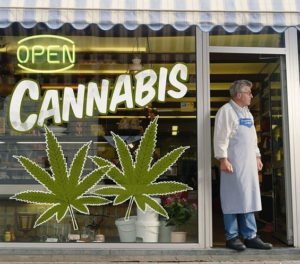Crossing into Colorado, I couldn’t miss the big billboard promoting cannabis as a “nutritional” product of great benefit to “humans and pets”.
Huh?
Then later that week, in Denver, we drove downtown on a busy main thoroughfare– a distance of about 10 miles– and just for fun, counted cannabusinesses. We found 19, and I’m sure we missed a couple. It seemed they outnumbered liquor stores, licensed pharmacies, and supermarkets.
To me, that suggests a saturated market, at least in the big city. If form holds, we should anticipate an eventual “shakeout” of independent retailers in favor of larger, better funded companies. That may come via acquisition and consolidation, or in other cases, closures. I’d compare it to the disappearance of the corner liquor store and tobacco shop.
The next big step would be to find cannabis products, edible and perhaps smoked, on the shelves of large chain retailers and pharmacies — Even big discount warehouses that in recent years have begun to boost profits with liquor and “alternative” nutritional supplements.
Meanwhile, neighboring states may continue their longstanding restrictions on or even prohibition of cannabis products, which may contribute to smuggling. The border between our state and Colorado is hundreds of miles long and mountainous, so I doubt interdiction would prove terribly effective. The authorities would confiscate a percentage and probably miss the greater portion.
A side note: In California, which is looking at full legalization next year, we’re already seeing the emergence of a cannabis culture for so-called “high end” consumers. Product lines resemble Gwyneth Paltrow’s popular “Goop” catalog of seriously overpriced luxury goods, along with social “events” that are designed to market them to a targeted segment of the public. I keep thinking of hipster Tupperware parties. Here’s an article from the New York Times with a lot more detail.
If Colorado is a model, California should experience an initial influx of tax revenue from all this business activity, right when events have left them most in need (call me crazy, but I’m not counting on the Feds contributing much to the post-fire rebuild). Then as the initial excitement dies down and cannabis settles into its role as yet another commercial product among many, we should expect to see corresponding steep declines in price, followed by a decline in tax revenue.
If estimates hold, around one in nine regular users will develop a substance use disorder and many will require treatment. Hopefully some of that tax revenue will be used to improve treatment access, the way it is with gambling. However, the reality is that years later, the gaming industry contributes only a tiny share of its revenue to the treatment fund, and State governments have reduced their own contribution, often to virtually nothing. I figure the same may happen with cannabis.













I’ve recently heard in the news that they’ve been cracking down on a lot of the dispensaries in Colorado and there have even been a few raids that have taken place over the past few weeks. I find it truly amazing that these markets can generate so much income even if the market is over saturated. I also heard in the news that you are now able to purchase marijuana in California recreationally as well. With the large profit margins and the taxes associated with marijuana I believe that this trend will continue and more state will follow suit. Keep up the good work on these post, I shared this with a few friends and the all really enjoyed it.